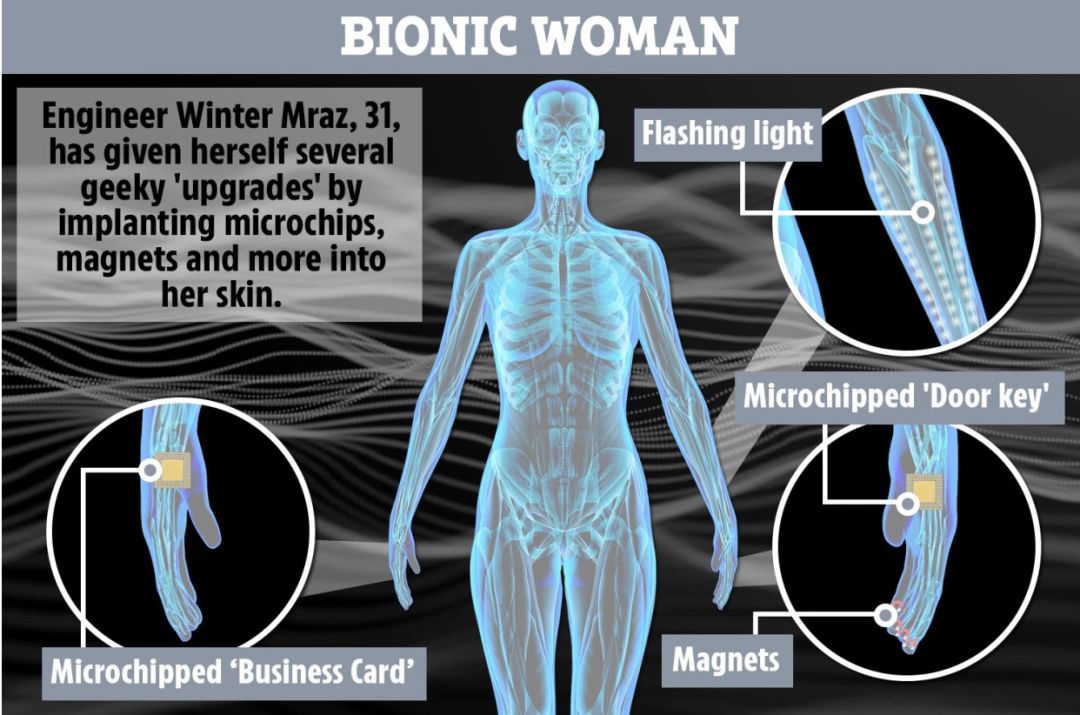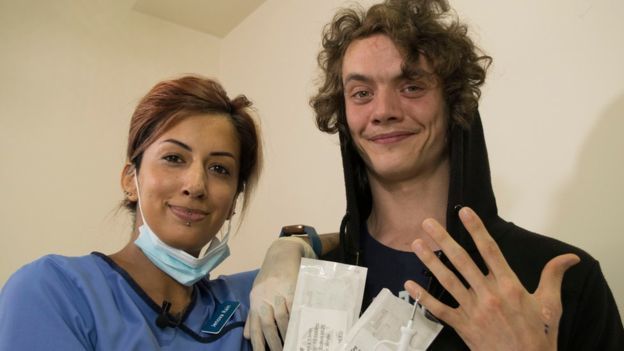Perhaps in the future, the imagination of these “biohackers” will really become a reality.
Editor’s note: This article comes from WeChat public account “ Big Data Abstracts ” (ID: BigDataDigest), author Niu Wanyang.

The first year of science fiction 2020 has quietly arrivedWe may be closer to the sci-fi scene in the novel.
Although in reality, our technology is far from being a big movie, but some people are eager for this “superhuman” life , and want to implant some Device to transform your body and find a more convenient way to interact.
Recently, according to DailyMail, a female engineer implanted house keys and LED lights into her skin , and she wanted to improve her body through implantation.
Winter Mraz, 31, came up with the idea because of a serious car accident. Her back was bolted together by a surgeon, her ankle and knee were broken, and a 3D printed implant was used. Thing replaced her knee.
Winter said, “If it weren’t for this 3D printed ‘knee’, I would never be able to walk again.” The accident gave her courage, and Winter then began to volunteer to try some other implants and wanted to change herself life.
The RFID (radio frequency identification) chip on her left hand can open the door, which means she doesn’t need a key and can free up her hand to take a cane.
The NFC (near field communication) chip in her right hand has many uses, such as allowing her phone and tablet to easily share data, and also storing her personal information and some important medical information in case of emergency.

A magnet was implanted in one of her fingertips that allowed her to sense electromagnetic fields, which she said helped her work.

She also implanted two LED lights on her forearm, and when the magnets pass through, they glow, illuminating her skin from inside.
The implantation of LED lights in the forearm is because Winter likes things that emit light. At the same time, she also said,” I actively want to implant these, not passive. “I can take the initiative to get rid of some potential hazards now, instead of waiting until something unexpected happens and then solve it passively.” For example, I will not forget to bring the keys, because they are always in my hands. “
Winter believes that wearable technologies, such as the Apple Watch and Fitbit and other “doctor wrist” health monitors, have become popular in the past few years, and she believes implants are the next step. “But implants are not inevitable. I think they are getting better, more durable, cooler and more functional. This will become another option for people.”
Winter also said very honestly, “I think that if you have the ability to make a living, you can completely change your body. However, people with disabilities have no choice. Some implants are just for us.” Life is very optimistic. Although she suffered a car accident and had to replace her knee, she was still able to face it and even started to improve her life.
The BBC reports that more and more people claim to be “transhumanists,” and Winter is one of them. They believe that they are the pioneers of the future, in which all people are connected to machines, making them faster or smarter.
Bio-hacking: Add “super power” to yourself with technology
This crazy lady is not alone. A group of people who are very optimistic about technology and have the courage to try are practicing such “self-reform” together.
It is reported that more than 4,000 people in Sweden can use their index fingers to unlock office doors, board trains, enter concert halls, or touch each other ’s mobile phones to exchange personal social information. This was achieved thanks to a rice chip-sized microchip implanted in their fingers.
They call themselves “biohackers.” To put it simply, it is a person who transforms his body with drugs or scientific devices to break through physical limitations.
Only in the United States, there are tens of thousands of active biological hackers, including scientific researchers and celebrities.
Among them, one of the hardest “biohackers” is Patrick Paumen. The top bio-hacker from the Netherlands had implanted 14 chips in his body-9 RFID implantable tags and 5 neodymium magnet implants.
But thanks to these chips, Paumen has gained super powers that ordinary people don’t have.
For example, fingers can attract various metals;

You can swipe your door to unlock and unlock your phone;

You can even use your body to sense magnetic fields, store information, troubleshoot electronic devices, and more. He also came to Beijing because of participating in a technical event, and performed a “brush empty subway gate” at the subway entrance, which is amazing.
With the development of artificial intelligence technology, this group of explorers is no longer satisfied with simply implanting chips to brush access control. For example, Steven Ryall, a 26-year-old technical operator from Manchester, said he wants to implant chips to make “ smart hands “. He said, “We have smart TVs, smart phones, and everything is smart. So why can’t I be more ‘smart’?”

Steven Ryall and the doctor who implanted the chip
Steven believes that transhumanism is a reasonable next step for humans. He wants to program the chip implanted in the body to adapt to his own physiological response.
His first implant was performed in a private clinic in Leicester, MicrochipThe tablets are delivered to the back of the hand through a syringe. “I’m slowly turning myself into a machine. I don’t mind being a biologist, but if I can become a person with some machinery, it’s much better than the ordinary one.”
Steven said that the chip he implanted is essentially similar to a chip in a contactless bank card. “I can use an RFID or NFC reader and connect it to the chip I want to program, and then let the chip recognize the chip in my hand and do whatever I want . “
Steven is a representative of this type of human “ self-upgrading “, but he can also understand why people think this is an extreme thing. Although his friends and family think it’s “weird”, he believes they will start doing so in the next five years.
At the moment, some small makeovers are just interesting gimmicks. However, “superhumanists” believe that “physical enhancement” in science fiction may one day eradicate disease and disability.
Musk’s Neuralink: Committed to linking the human brain with the computer to make humans and AI symbiotic
The use of new technologies to transform the human body is also gradually entering the real business world. Such as “Silicon Valley Iron Man” Musk’s brain-computer interface company Neuralink.
In July 2016, Neuralink was incorporated in California and registered as a “medical research” company. The company claims to be committed to creating devices that can be implanted in the human brain.The ultimate goal is to help humans keep up with advances in artificial intelligence and focus on the ability of the brain to grow through technology.
July 2019, Musk revealed to the public the latest developments of this mysterious company at a press conference . Musk said that during these two low-key years, Neuralink is working on a machine similar to a “sewing machine” that can use a laser beam to pierce the skull with a series of small holes and implant neuron-like signal-transmitting components. And it’s as easy to operate as a mobile phone.

Musk is very optimistic about this project. One day, neural fusion technology may help humans get rid of a series of diseases, such as helping amputees to restore mobility or helping people listen, speak, and watch.
After implantation, it can be docked with a small device behind the ear and connected to a mobile phone.

Of course, the most interesting topic for this sounding brain-computer project is, is it safe?
At a press conference last July, Matt Macdougall, a brain surgeon who works for Neuralink, described the safety issues that are currently of most concern. He said that security is currently the most important issue for Neuralink, and the company has done a lot to achieve this.
Musk said that Neuralink’s brain-computer interface implant technology plans to achieve three goals:
-
Under the condition of ensuring safety and sustainability, gradually increase the number of neurons read and written;
-
At each stage, produce equipment for patients with urgent medical needs;
-
Make brain-computer interface surgery as easy and automated as laser myopia surgery.
So far, we have some understanding of this mysterious brain science company, and we probably understand Musk’s new vision.A novel named “Accelerated World” presents a future world. Everyone will wear a neural connection device. Through this biological device, the content displayed on a computer screen can be directly projected onto our retinas. The same kind of neural device can also program the nerves in our brain. For 1s in the real world, we can perceive 1000s in the virtual world.